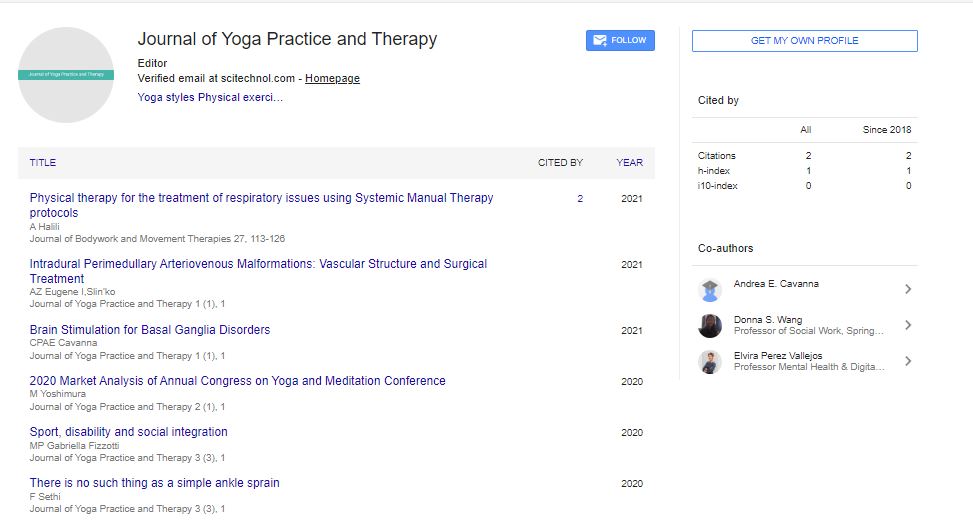Commentary, J Yoga Pract Ther Vol: 4 Issue: 1
Yoga For Health And Healing
Rashmi Arasappa*
Department of Psychiatry, National Institute of Mental Health and Neurosciences (NIMHANS), India
*Corresponding Author: Rashmi Arasappa Department of Psychiatry, National Institute of Mental Health and Neurosciences (NIMHANS), Bangalore, Karnataka, India, E-Mail ras3476@nimhans.ac.in
Received: 04 November, 2021; Accepted: 11 November, 2021; Published: 25 November, 2021
Keywords: pranayama,Healing,therapeutic practice,wretchedness,Yoga Practice
Introduction
Yoga as treatment is the use of yoga as a workout, which consists primarily of poses known as asanas, as a delicate sort of movement and relaxation done specifically to improve wellbeing. Reflection, symbolism, breath practice (pranayama), and quieting music, as well as postural yoga, are all common features of this form of yoga. At least three types of health guarantees have been made for yoga: supernatural cases for middle age haha yoga, including the force of mending; unsupported cases of organ framework advantages from the act of asanas; and that's just the beginning or less strongly supported cases of explicit clinical and mental advantages from studies of various sizes utilizing a variety of strategies.
Effective audits have discovered beneficial effects of yoga on low back pain and wretchedness, but despite extensive research, there is little evidence of efficacy for specific clinical diseases. Feeble methodology has impeded the study of injury-prone yoga. Asanas (stretches), pranayama (breathing exercises), and savasana (relaxation) are typically included in yoga programmes used for treatment (resting). Although the asanas of modern yoga are linked to a middle-aged haha yoga tradition, they were not widely practiced in India until the mid-twentieth century.
Since the late twentieth century, the number of yoga schools and styles has grown rapidly in the Western world. By 2012, there were around 19 different types ranging from Ashtanga Vinyasa Yoga to Viniyoga. These emphasize a variety of aspects, including a high-impact workout, asana precision, and the otherworldliness of the Hatha yoga tradition. Schools with distinct styles can help to define these points of view. Bikram Yoga offers a high-impact practice method, with rooms heated to 105 degrees Fahrenheit (41 degrees Celsius) and a good grouping of two breathing activities and 26 asanas performed in each session. Iyengar Yoga emphasizes proper stance alignment, progressing gradually with the use of props if necessary, and finishing with relaxation. In each class, Sivananda Yoga emphasizes transcendent practice with 12 key postures, Sanskrit recitation, pranayama breathing activities, contemplation, and unwinding, as well as a focus on vegetarian cuisine.
Types of Actions
The International Association of Yoga Therapists defines yoga treatment as "the method involved with enabling people to advance toward further developed wellbeing and prosperity through the use of the lessons and practices of Yoga," referring to it as "the method involved with enabling people to advance toward further developed wellbeing and prosperity through the use of the lessons and practices of Yoga. As quickly as 1940, Iyengar turned into related to yoga as a remedy for everyday situations like sinus issues, spinal pain, and fatigue. Iyengar turned into capable of push people via torment "to [show] them extra opportunities." In the 1960s, he organized more than one people, for example, Diana Clifton and Silva Mehta to deliver this healing yoga; precise asanas have been applied for diverse situations, and non-medicinal Iyengar Yoga teachers have been knowledgeable to permit understudies recognize that traditional instructions have been now no longer affordable for "actual clinical problems". Mehta confirmed a healing yoga magnificence with inside the Iyengar Yoga Institute in Maida Vale from its commencing in 1984; she contributed "Healing Programs" for situations like joint inflammation, spinal pain, knee ligament issues, pregnancy, sciatica, scoliosis and varicose veins with inside the Mehta’s' 1990 ee-e book Yoga the Iyengar Way. Newcombe contends that during Britain, yoga "to a splendid quantity stayed farfar from unmistakable battle with the scientific calling through on the equal time professionalizing with instructive talents and conceding to scientific skill." After Richard Hittleman's Yoga for Health collection on ITV from 1971 to 1974, the collection maker Howard Kent mounted a cause, the Yoga for Health Foundation, to "Investigation into the remedial blessings to be gotten with the aid of using the act of yoga"; non-public publications began out in 1978 at Ickwell Bury in Bedfordshire. The Foundation expressed that yoga changed into now no longer a remedy or restore however as an alternative had "remedial blessings", irrespective of whether or not physical, mental, or enthusiastic, and it labored mainly with "the clearly impaired
Sports Medication
According to the attitude of sports activities medication, asanas paintings as dynamic stretches, helping with defensive muscle groups from injury; those need to be executed in addition on the 2 sides, the greater grounded facet first on every occasion applied for real restoration.
 Spanish
Spanish  Chinese
Chinese  Russian
Russian  German
German  French
French  Japanese
Japanese  Portuguese
Portuguese  Hindi
Hindi 